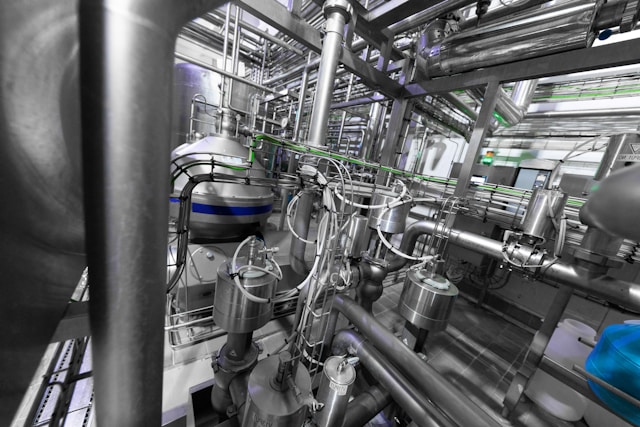
Emerging Trends in Flow Meter Technology: How Industrial Flow Meter Manufacturers are Innovating for the Future
Smart Flow Meters: Enhancing Precision and Control
The emergence of smart flow meters is transforming the industry by offering increased precision and enhanced control over industrial processes. These devices, equipped with advanced sensors and digital communication capabilities, provide real-time data and diagnostics that help operators make informed decisions quickly.
1. Real-Time Monitoring and Data Analytics
One of the most significant advancements in flow meter technology is the ability to monitor flow rates in real-time. Smart flow meters continuously measure fluid movement and transmit data to centralized systems, allowing operators to adjust processes instantly. This real-time data helps improve process control, reduce waste, and ensure product consistency across industries such as pharmaceuticals, food and beverage, and chemicals.
Additionally, these meters are capable of self-diagnostics. By identifying potential issues, such as clogs, leaks, or calibration drift, smart meters allow operators to address problems before they result in costly downtime or safety hazards. The use of smart meters also supports predictive maintenance by identifying wear and tear on equipment, thereby minimizing unexpected failures and reducing repair costs.
2. Communication and Integration with SCADA Systems
Smart flow meters are designed to integrate seamlessly with Supervisory Control and Data Acquisition (SCADA) systems, enabling enhanced automation and remote monitoring. With digital communication protocols like HART, MODBUS, and Ethernet/IP, these meters provide a direct link to a plant’s automation system, feeding crucial flow data into a broader network of sensors and controllers.
This capability allows for a greater level of control over industrial processes. Operators can adjust flow rates remotely, view real-time analytics, and even receive alarms when critical thresholds are breached. The result is a more responsive and efficient industrial environment that can adapt to changing conditions with minimal human intervention.
IoT Integration: Connecting Flow Meters to the Digital Ecosystem
The Internet of Things (IoT) has brought unprecedented connectivity to industrial processes, and flow meters are increasingly benefiting from this trend. By integrating flow meters with IoT platforms, manufacturers are creating smart ecosystems where data from multiple devices is collected, analyzed, and acted upon in real-time. This digital transformation is making flow meters more intelligent, efficient, and versatile.
1. Industrial IoT (IIoT) and Predictive Analytics
Industrial IoT platforms allow flow meters to connect with other industrial equipment to create a network of smart devices that continuously exchange data. By analyzing flow data in conjunction with other operational metrics, businesses can gain deeper insights into their processes, optimize production, and minimize inefficiencies.
For instance, in the oil and gas industry, IIoT-enabled flow meters can monitor the flow of crude oil through pipelines while simultaneously analyzing pressure, temperature, and vibration data from other sensors. This comprehensive view of the system enables operators to detect potential issues such as leaks or blockages, optimize flow rates, and improve overall operational efficiency.
Moreover, IoT integration allows businesses to implement predictive analytics. By analyzing historical flow data and identifying patterns, companies can predict equipment failures before they occur, schedule maintenance proactively, and reduce the risk of costly downtime.
2. Remote Monitoring and Cloud Connectivity
IoT-enabled flow meters can be connected to cloud-based platforms, giving operators the ability to monitor and control flow rates remotely from any location. This is particularly beneficial for industries that manage geographically dispersed assets, such as water treatment plants, pipelines, and renewable energy facilities.
Cloud connectivity allows for centralized data storage and easy access to flow metrics, which can be analyzed to improve decision-making and operational efficiency. In addition, remote monitoring capabilities reduce the need for manual inspections and provide real-time alerts in case of system anomalies, contributing to improved safety and performance.
Material Advancements: Durability and Versatility in Challenging Environments
As industrial processes become more complex, manufacturers are seeking flow meter technologies that can withstand harsher environments and more aggressive fluids. Innovations in materials have been critical in ensuring that flow meters remain durable, reliable, and accurate in extreme conditions.
1. Corrosion-Resistant and High-Temperature Materials
In industries such as chemical processing and oil and gas, flow meters are often exposed to corrosive chemicals, high temperatures, and high-pressure environments. Traditional materials like stainless steel may not always offer the level of durability required in these settings. To address these challenges, manufacturers are increasingly using advanced alloys and specialized coatings that resist corrosion and degradation.
For example, meters made from materials like Hastelloy, Inconel, and titanium are highly resistant to corrosive chemicals and can maintain accuracy in extreme temperature and pressure conditions. This ensures that flow meters continue to perform reliably, even in the most demanding environments, reducing the need for frequent replacements and maintenance.
2. Customization and Application-Specific Designs
Manufacturers are also developing flow meters that are specifically designed to meet the unique needs of different industries. For instance, electromagnetic flow meters, which are ideal for measuring conductive fluids, are now available with liners made from materials such as PTFE and PFA, which can withstand aggressive chemical flows and high temperatures.
This trend toward customization allows manufacturers to deliver flow meters that are perfectly suited for specific applications, ensuring higher accuracy, longevity, and overall performance. As a result, industries like pharmaceuticals, water treatment, and petrochemicals are able to achieve better process control and product quality.
Energy Efficiency: Reducing the Environmental Footprint
Sustainability and energy efficiency are increasingly important in modern industrial operations. Flow meter manufacturers are responding to these demands by developing energy-efficient devices that not only help industries optimize their resource usage but also contribute to their environmental goals.
1. Low-Power Flow Meters
As industries seek to reduce energy consumption, flow meter manufacturers are introducing low-power designs that maintain high performance while minimizing energy usage. These meters are particularly valuable in remote or off-grid locations, where power sources may be limited.
Battery-powered flow meters, for example, can operate independently for extended periods, providing accurate measurements in areas where traditional power sources are unavailable. These energy-efficient meters are commonly used in applications such as water distribution networks and environmental monitoring, where energy conservation is a priority.
2. Sustainable Manufacturing Practices
In addition to creating energy-efficient products, flow meter manufacturers are also adopting sustainable practices in their production processes. Many companies are exploring ways to reduce waste, minimize energy consumption during manufacturing, and use eco-friendly materials in their products. This focus on sustainability is driving the development of flow meters that align with broader environmental goals, helping industries reduce their carbon footprint.
Shaping the Future of Flow Measurement
The innovations in flow meter technology are not only improving the precision and efficiency of industrial processes but also shaping the future of flow measurement across industries. With the continued integration of smart technology, IoT, and advanced materials, the future of flow meters looks promising.
1. Enhanced Automation and Artificial Intelligence (AI)
The future of flow meters will likely see further integration with AI and machine learning algorithms. These technologies will enable flow meters to learn from historical data and autonomously adjust flow rates, optimizing processes in real-time without human intervention. This will contribute to greater operational efficiency, resource conservation, and cost reduction.
2. Expanding Applications
As flow meter technology continues to advance, we can expect to see its application expand into new industries and environments. For example, flow meters may become more prevalent in renewable energy systems such as wind, solar, and hydropower, where accurate measurement of fluid and gas flows is critical for optimizing energy generation and storage.
Conclusion
Flow meter technology is rapidly evolving, driven by the demand for smarter, more efficient, and sustainable solutions. Industrial flow meter manufacturers are at the forefront of these innovations, delivering devices that integrate advanced features such as real-time monitoring, IoT connectivity, and energy-efficient designs. As industries continue to prioritize precision, automation, and environmental responsibility, the role of flow meters in optimizing processes and ensuring compliance will only grow in importance. By embracing these emerging trends, manufacturers are helping shape a future where flow measurement is more accurate, intelligent, and efficient than ever before.











